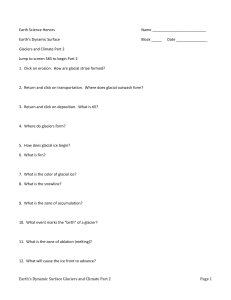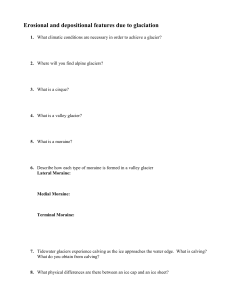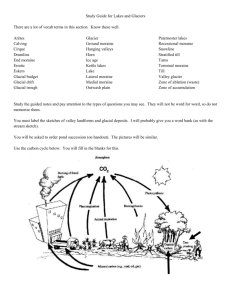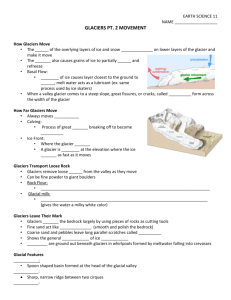Glacial Legacies of New York State - North Syracuse Central School
advertisement
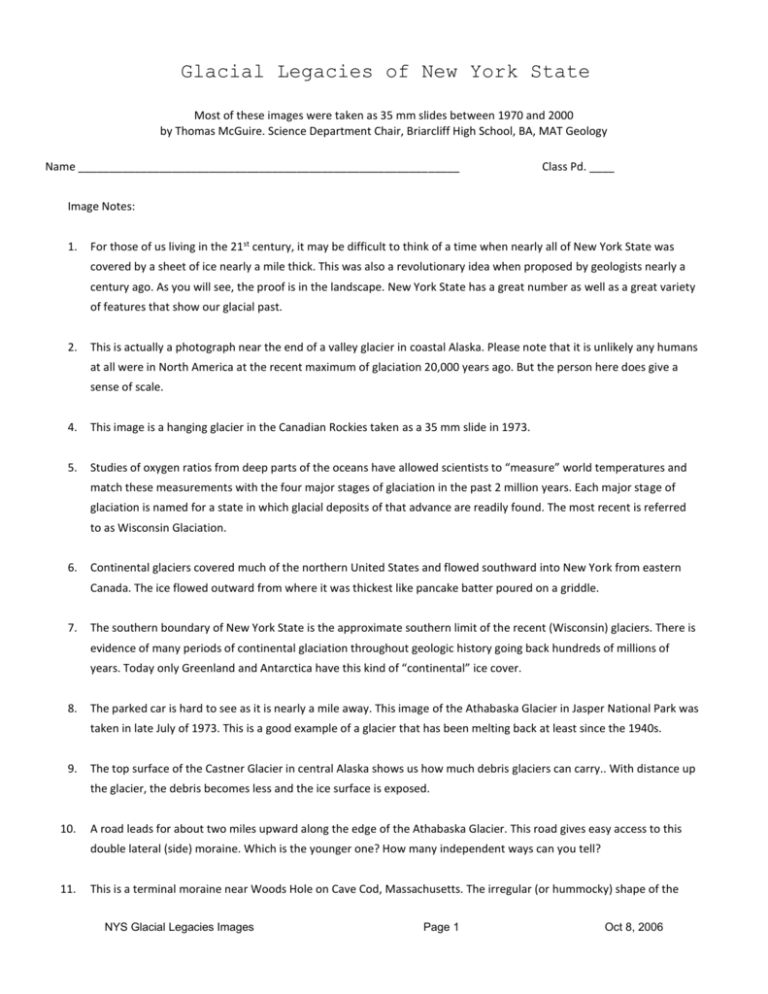
Glacial Legacies of New York State Most of these images were taken as 35 mm slides between 1970 and 2000 by Thomas McGuire. Science Department Chair, Briarcliff High School, BA, MAT Geology Name _____________________________________________________________ Class Pd. ____ Image Notes: 1. For those of us living in the 21st century, it may be difficult to think of a time when nearly all of New York State was covered by a sheet of ice nearly a mile thick. This was also a revolutionary idea when proposed by geologists nearly a century ago. As you will see, the proof is in the landscape. New York State has a great number as well as a great variety of features that show our glacial past. 2. This is actually a photograph near the end of a valley glacier in coastal Alaska. Please note that it is unlikely any humans at all were in North America at the recent maximum of glaciation 20,000 years ago. But the person here does give a sense of scale. 4. This image is a hanging glacier in the Canadian Rockies taken as a 35 mm slide in 1973. 5. Studies of oxygen ratios from deep parts of the oceans have allowed scientists to “measure” world temperatures and match these measurements with the four major stages of glaciation in the past 2 million years. Each major stage of glaciation is named for a state in which glacial deposits of that advance are readily found. The most recent is referred to as Wisconsin Glaciation. 6. Continental glaciers covered much of the northern United States and flowed southward into New York from eastern Canada. The ice flowed outward from where it was thickest like pancake batter poured on a griddle. 7. The southern boundary of New York State is the approximate southern limit of the recent (Wisconsin) glaciers. There is evidence of many periods of continental glaciation throughout geologic history going back hundreds of millions of years. Today only Greenland and Antarctica have this kind of “continental” ice cover. 8. The parked car is hard to see as it is nearly a mile away. This image of the Athabaska Glacier in Jasper National Park was taken in late July of 1973. This is a good example of a glacier that has been melting back at least since the 1940s. 9. The top surface of the Castner Glacier in central Alaska shows us how much debris glaciers can carry.. With distance up the glacier, the debris becomes less and the ice surface is exposed. 10. A road leads for about two miles upward along the edge of the Athabaska Glacier. This road gives easy access to this double lateral (side) moraine. Which is the younger one? How many independent ways can you tell? 11. This is a terminal moraine near Woods Hole on Cave Cod, Massachusetts. The irregular (or hummocky) shape of the NYS Glacial Legacies Images Page 1 Oct 8, 2006 land with randomly arranged hills and depressions is typical of terminal (end) moraines found here and across much of New York State. The moraines further north show brief advances during the long period of retreat. (melt back) 12. The orange places on this map are places where terminal moraines can be observed. The Ronkonkoma Moraine (south) and the Harbor Hill Moraine (north) giving the island its fish shape. The Valley heads Moraine can be seen in valleys south of the Finger Lakes in Western New York. 13. Choconut Creek in Vestalwest of Binghamton cuts through thick banks of unsorted glacial till. 14. Apparently this kettle hole flooded in rainy weather. Then it froze over as the water drained out through the ground. There is no surface outlet as this is a closed depression. 15. Long Island was constructed by two parallel end moraines that can be traced eastward to the Rhode Island and Massachusetts coasts. 16. In this view we are looking south across Long Island from the Harbor Hill Moraine. Hence the elevated land on which the photograph was taken, southward toward the distant hills Ronkonkoma Moraine. 17. Note the position of Montauk Point on the last map slide (#14) where the dotted line touches Long Island. 18. This is along NY Route 21 between Naples and North Cohocton, NY. The moraine is evident only in the valleys between the large hills of shale bedrock. 19. Outwash can be identified by its layers and sorting of particle size. 20. Many of the North Shore beaches on Long Island have large bounders that have been weathered and fallen from the bluffs (Harbor Hill Moraine) by rain and wave action on Long Island Sound. 21. The sandy beaches of the south shore, backed by wind formed dunes, are a marked contrast with rocky north shore beaches that eroded out of the high bluffs. 22. Gravel pits, such as this one on the western Catskills hold New York’s most economically valuable natural resource: sand and gravel. The sloping layers show that these sediments were deposited by water, probably very close to the melting edge of the retreating glacier. 23. The New York State Geological Survey has published a set of six large maps that show the surface deposits above bedrock throughout the state. Most surface deposits in this state are transported soils of glacial origin. 24. The stream looks smaller than it really is. The person is standing near the camera well above the wtaer. This river is about 10 m wide and too deep and swift to wade across. Students may be surprised to learn that glaciers melt yearlong from the bottom, while on top they melt only in the warmer non-winter months. Melt water lubricates the bottom of the ice. NYS Glacial Legacies Images Page 2 Oct 8, 2006 25. A good way to find eskers is to look for small, narrow ridges in broad valleys. This one is along Route 6 at Shrub Oak about half a mile west of the Taconic Parkway in Westchester County. Although this esker can be followed only about 100 meters, some eskers in other states can be followed for as much as 50 miles! 26. Imagine a great glacier with a (very cold) stream running toward you in a tunnel and depositing this ridge. 27. Eskers are quite common in the western Catskills. 28. Identify the large rocks shown here by type (igneous metamorphic or sedimentary) and the specific rock names. All were found along the beach at Croton Point, NY about 30 north of New York City. (Croton Point is largely composed of glacial till.) 29. This cobblestone home is on NY 5 & US 20 (the main street) in East Bloomfield, south of Rochester, NY. There are many of these cobblestone houses in this part of New York State. As with many old homes, insulation is poor and wiring is difficult to install. 30. Erratics as large as this are rare. This one has come to rest in Rockefeller State Park in Westchester County. It is composed of a rock type common in the immediate area so it was probably moved only a short distance. 31. There have been many local myths about how this huge rock was lifted onto the three smaller rocks. Regardless, This large erratic, on NY 116 at North Salem, NY, was laid down on a pile of smaller rocks and sediment. When much of the fine sediment was eroded away, the large boulder came to rest on three smaller rocks. Such a rock is called a perched erratic. 32. North of the Finger Lakes is a region of north-south aligned hills known as drumlins. Most drumlins have a relatively blunt northern end and trail off to the south. This alignment was thought to show the direction in which the ice was advancing, even during melt-back. But many geologists now think that drumlins were aligned at least in part by flowing subsurface melt water, 33. Topographic maps from this area show drumlins very clearly. This drumlin in western New York State shows the steeper north (right) slope and a more gradual slope to the south. Like other drumlins, it is quite narrow from east to west. Hill Cumorrah is shown on this map, where the Church of Jesus Christ of Later Day Saints (or Mormon Church) began in the dearly 1800s is classic drumlin shape that is noted for its historic importance. Moroni was the name of the angel that delivered the golden plates. 34. Many drumlins can be seen along NY Rout 31 near Savannah, NY and also along this part of the New York State Thruway. (Interstate 87) 35. Access to the beach at Chimney Bluffs is relatively easy by local roads. The bluffs constantly change due to rain and wave erosion. NYS Glacial Legacies Images Page 3 Oct 8, 2006 36. This is the third image from my hike up the Castner Glacier in 1973. The streams of rock debris make the flow direction evident, The high ice fields are behind us at an even higher elevation. 37. The image was taken along US 550 between Silverton and Ouray, CO. This is one of the most spectacular high mountain roads in the US. The steeply dipping rock accentuates the V-shape. 38. Unfortunately, trees disguise most of the V-shaped valley in New York. The kayakers paddled up from a launch point below. This is the lower of the three major waterfalls. 39. In spite of it name, there are few glaciers left in Glacial National Parke due to global climate change. The permanent ice has melted back so much that long-lasting snow fields are now found where moving ice used to be. 40. The distinct “U-shape” valley was created by an advancing glacier in the western Finger Lakes. Another glacial feature evident in this view is a through valley. When you travel to the end of one stream valley and cross into another, the divide is usually a high ridge. But just beyond the large building near the center of the picture is the divide between a south flowing stream flowing toward us, and another stream flowing in the opposite direction. The divide is at the bottom of this through valley. 41. This is a satellite image taken in clear weather. Can you locate the region on the map in the New York State Reference Tables? 42. The photo was taken on a cross-country airline flight, obviously in the winter. 43. Most of the Finger Lakes have their south ends in the Allegheny Plateau and extend into the flatter lands of the Lake Ontario Plain. The point jutting into the lake is knows as Seneca Point. This lake is nearly 100 m deep at the center of this image. 44. When the ice moved through the Finger Lakes region, it scoured and deepened north-south valleys. but not valleys that trended east-west. The town of Montour Falls is named after this cataract created when the glaciers deepened the valley that runs south of Seneca Lake, but not the valley that holds this stream. The stream flows through a perched valley that ends in a “hanging valley waterfall.” Taughannock Falls north of Ithaca, Watkins Glen and many other waterfalls in the Finger Lakes are hanging falls. 45. Glacial polish is rare in the soft sedimentary rocks that cover most of New York State. The best examples have been recently exposed by soil removal. In addition to the striations, some scratches can be seen that were made by farm machinery. 46. The striated rock surface near the bottom of this picture is near the top of Hunter Mountain in the Catskills. It is nearly a mile above sea level showing that the continental ice sheet must have been at least a mile thick in the nearby Hudson Valley. 47. This bedrock surface was exposed by the construction of a new exit from US Route 9 in the 1970s. Since then, the rock NYS Glacial Legacies Images Page 4 Oct 8, 2006 surface has lost much of its sheen due to weathering. 48. NY Route 22 has been cut through this grooved surface, hence the abrupt end of the grooves north of Whitehall, NY. Ice is too soft to carve rock. It’s the rocks pushed along the bottom of the ice that do the carving. 49. Limestone is a rock hard enough to not break up, but soft enough scratch easily. Similar, partly rounded and scratched rocks can be found in many gravel pits, especially in Western New York State. 50. Crescent gouges are concave upstream. Chatermarks occur in large grooves and are concave downstream. There are many of both near the summit of Bear Mountain near Peekskill. 51. Bedrock surfaces shaped by the moving ice include roche moutoneé. This is a French term that translates as “sheep mounds” because the right surface is like the sloping neck of a grazing sheep. The left end is steeper, like the rear end of the sheep. The gentle slope of these rocks always points north while the southern side is the steeper, often plucked end. (These two little girls graduated from college about a decade ago.) 52. Canopus Lake is along NY 301 in Clarence Fahnestock State Park about 50 miles north of New York City. 53. The Hudson River is a sea level estuary of the Atlantic Ocean all the way up to Albany. Where it flows through the Hudson Highlands it is a fjord: A deeply glaciated sea level passage between mountains. This view is from Breakneck Ridge south toward West Point. 54. Monument Valley is familiar to many John Ford/John Wayne classic western films. It is also featured at the beginning of the recent climbing film, Vertical Limit. This is a Navajo Nation Tribal park and operated by the Navajo Indian Nation on he Arizona-Utah border. That’s me in the red shirt. The dude on the motorcycle’s wife took the picture. (Slide 2) 55. You are looking from Basin Mountain eastward along the ridge of mountains. That hot summer day was not the best time to carry a heavy backpack along this ridge. 56. In my youth I spent many summer days at this town park about half a mile from my parents’ home. The tree was a tiny sapling then. I did not think about how the hill formed until I looked at it many years later with educated eyes. 57. Consider that the ice always moves forward. But when the weather gets warm enough, the ice melts back faster than its forward movement. Hence the trivia question. “When the glaciers receded from New York State, which way did the ice move?” (southward!) 58. The melting glaciers created large lakes in places where the land sloped downward to the north. Many streams changed their flow both during and after glaciation. Look at the streams that join Canandaigua and Cayuga Lake to make a “Y.” Kuka Lake also makes a “Y” shape. When streams join, they usually drain out toward the bottom of the “Y.” Other channels greatly affected in the postglacial period. The New Milford Sluiceway, south to Binghamton in Pennsylvania, is a deep valley that now has no large stream. The Mohawk River also briefly carried the main discharge from the Lake Ontario region, augmented by melt water. (See the fourth and final map on this slide.) NYS Glacial Legacies Images Page 5 Oct 8, 2006 59. Before the glaciers melted back into Canada, the St. Lawrence River outlet to the north was blocked by thick ice. The lowest level outlet for the melt water at that time was via the Mohawk and Hudson Rivers. At Syracuse the temporary outlet fell over a hard, limestone cap rock to carve a huge waterfall. Although its existence was relatively brief, the power of the waterfall carved out a deep plunge pool below these cliffs. 60. Croton point has a complex origin. (1) It was a medial moraine in the Hudson River Valley, (2) Sediments of Lake Albany made varves on top of the original surface. (3) Resumed ice flow deposited more till as seen here. (4) The Croton River deposited sediments in the Hudson east of the southern section of the point. (5) Excavation of sand and gravel carried away some of the hills, especially at the north end of the point. (6) Dumping of local trash and garbage was followed by a soil cover and landscaping for sport fields. 61. Earlier you saw waterfalls made by the re-routing of the Genesee River to make Letchworth Gorge (The original valley was about 10 miles to the east.) The Niagara River was displaced to the East. The falls is eroding upstream at the impressive rate of about a meter per year. Undercutting and collapse is the major mechanism of this upstream migration. 62. The glaciers were very heavy. The added weight on the land caused it to sink. Although we cannot be sure how much eastern North America was depressed, we can measure the rebound. This map shows that the greatest rise has taken place where the ice was thickest in eastern Canada. 63. The northern shore of Lake Ontario, where it flows out into the St. Lawrence River has risen more than the southern shore. As a result, lake levels have risen along the southern shore, drowning stream valleys such as Sodus Bay. The next picture will show the bar that has formed across the mouth of the bay. 64. The bluff from which this picture was taken is an eroded drumlin. Notice that a long wave built bar that separates Sodus Bay, on the left, from Lake Ontario on the right. Chimney Bluffs (slide 34) 65. Pattern ground can be faintly observed in some hilltop places in the Western Catskills that were never farmed. This image was taken in Colorado. Pattern ground in New York is a very subtle resut of the post-glacial climate in New York. 66. The maps shows general areas where features of glaciation can be observed. 67. Glaciation was not restricted to North America. Continental glaciers also covered much of Eurasia. 68. Red numbers show where New York State pictures in this PowerPoint were taken. Below are parks and other places, by county, that display glacial landforms. Check a state road map, local topographic map or DeLorme NYS atlas for exact locations and access. Niagara Niagara Falls Altered stream course Livingston Letchworth State Park Altered stream course Monroe Mendon Ponds Eskers, kames, kettles NYS Glacial Legacies Images Page 6 Oct 8, 2006 69. Ontario Hill Cumorah Drumlins Wayne Chimney Bluffs Drumlins Seneca Junius Ponds Kettles Tompkins Tagonick Falls Hanging Valley Onondaga Clark Reservation Post-glacial waterfall Broome Chenengo Valley State Park Esker, kettles Herkimer Potholes at Little Falls Augmented stream volume Westchester Franklin D. Roosevelt State Park Kettle lakes Nassau Sunken Meadow State Park Terminal moraine Suffolk Lake Ronkonkoma Kettle lake Wildwood State Park Terminal moraine Montauk Point Terminal moraine Mount Rainier is a popular climb for those up to a long and grueling, but not technically difficult ascent. The upper part of the mountain is draped by glacial ice as a result of moist winds off the Pacific. This image was taken at the visitor center after a particularly snowy winter in the late 1970s. Normally, there is little or no snow left at this level. Thanks for your interest. NYS Glacial Legacies Images Page 7 Oct 8, 2006





